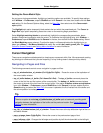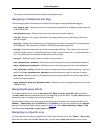
Tagging Tab. When the cursor is in the prototype, pressing Ctrl+Dot will navigate to the func-
tion and vice versa. If you do not set one of these options, you will be prompted with the Select
a Tag Dialog the first time you navigate from a symbol to its definition.
• Auto-close visited files - SlickEdit Core can automatically close a visited file, one that was
opened through symbol navigation but not edited. Click Window → Preferences, expand
SlickEdit and click General in the tree, then double-click the General setting. On the General
Options dialog, select the General Tab, then select the option Automatically close visited
files.
Navigating Between Multiple Instances
If more than one instance of the definition or reference is found, the Select a Tag dialog is displayed, from
which you can select the instance to navigate to. To go to the next occurrence, press Ctrl+G or use the
find_next command. To go to the previous occurrence, press Ctrl+Shift+G or use the find_prev com-
mand.
Alternatively, press Ctrl+Down (next_tag command) or Ctrl+Up (prev_tag command) to place the curs-
or on the next or previous symbol definition.
Using the Find Symbol View
The Find Symbol view (Search → Find Symbol) is used to locate symbols (tags) which are declared or
defined in your code. It allows you to search for symbols by name using either a regular expression, sub-
string, or fast prefix match. See Find Symbol View for descriptions of the options that are available.
More Symbol Navigation Methods
There are several other methods for navigating to symbols:
• The Symbols View shows the symbols for all tag files. Right-click in the view window and select Find
Tag to search for a specific symbol. You can also use the cb_find command to find the symbol under
the cursor and display it in the Symbols view.
• At the SlickEdit® Core command line, use the f command and completion keys (Space and ?) to enter
a tag name. For example, if tagging the C run-time library, type f str? on the command line for a list of
tag names starting with "str" (such as strcpy, strcmp, etc.).
• To navigate to a Slick-C® symbol, you can use the fp command (a shortcut for find_proc). If editing a
Slick-C macro, then enter the push_tag command (Ctrl+Dot) to find the symbol at the cursor. The
push_tag command actually calls the find_proc command with the symbol name at the cursor to per-
form the task.
Begin/End Structure Matching
Begin/End Structure Matching moves the cursor from the beginning of a code structure to the end, or vice
versa. This works for languages using curly braces "{ }", "begin" and "end", or any other defined begin/end
pairs.
Code Navigation
77


















